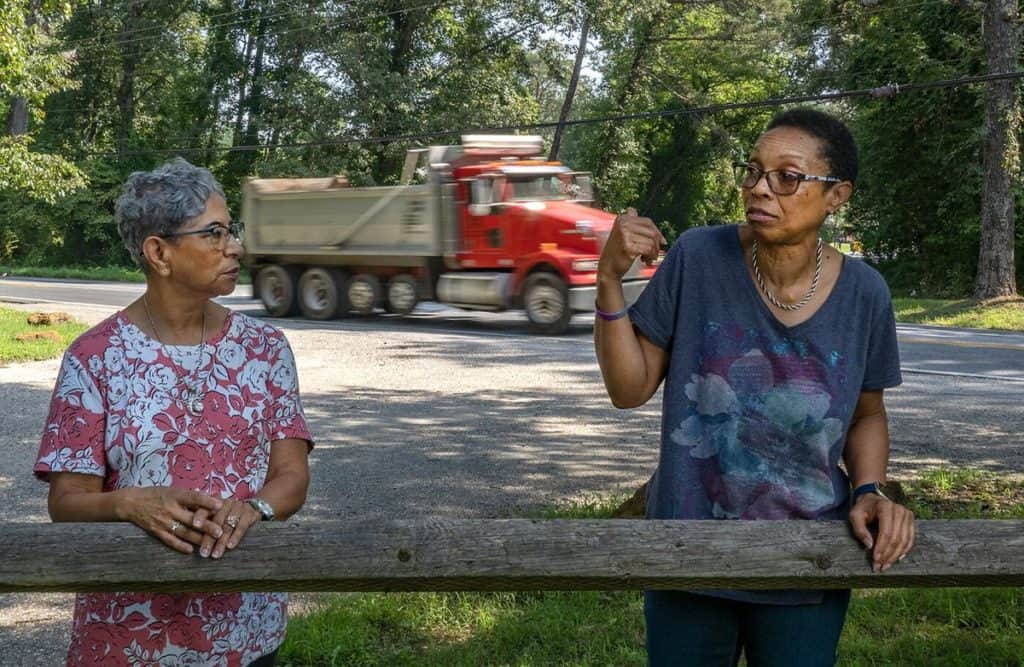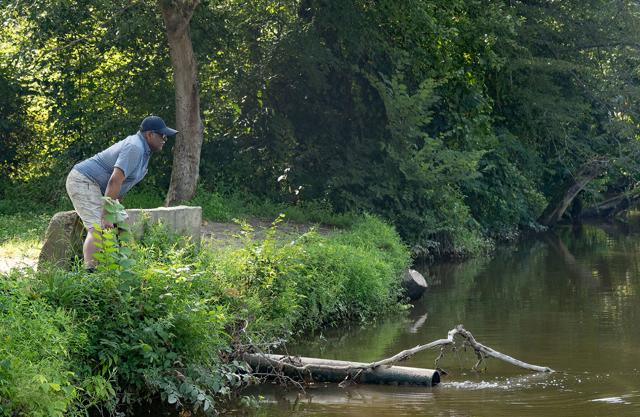Patuxent Riverkeeper Fights to Stop Mining Pollution in Lothian Community

By Timothy B. Wheeler, Bay Journal News Service
It was hard to hear Tracy Garrett and Celestine Brown describe how bad the traffic is on the narrow two-lane road running past their homes in the Lothian area of western Anne Arundel County.
That’s because their voices were repeatedly drowned out by the diesel rumble of dump trucks passing by as the two women stood speaking on a weekday inside the entrance to Sands Road Park.
“Speeding all the time, crossing the line all the time. They do what they want. It’s the wild, wild west,” Garrett said between trucks.
“It’s nuts, and it’s dangerous,” Brown added. “Bottom line, dangerous—mentally, physically, emotionally.”
Hundreds of the bulky vehicles traverse Sands Road daily on their way to and from a large sand and gravel quarry as well as two former quarries being filled in and returned to nature. As a result, Brown and Garrett contend, they and other residents living along what the county classifies as a scenic and historic road are subjected to poor air quality, excessive noise and other hazards that degrade their quality of life and threaten their health.
There are also five mobile home communities in the vicinity, each with its own small wastewater treatment plant that discharges into the nearby Patuxent River or one of its tributaries. In the past few years, five of the treatment plants have been out of compliance with their discharge permits more often than not, according to the U.S. Environmental Protection’s ECHO database.
And there are two closed rubble landfills nearby—one of which is now Sands Road Park, consisting of a couple of basketball courts and mostly open fields. Both are leaking cadmium, a toxic metal, into groundwater, tests have shown.
Patuxent Riverkeeper Fred Tutman calls the Sands Road area a “sacrifice zone,” a term used for communities—often low-income or people of color—where residents live close to polluting industries or other hazards. Tutman contends that residents there have had a series of disruptive resource extraction and waste disposal facilities imposed on them over the decades, and little or nothing has been done to ensure those facilities comply with what little is required of them.
“There’s a carrying capacity, a limit to what any community can tolerate,” Tutman said. “And these guys have way exceeded it, because the concept is, if you’ve got the right zoning you can have as many trucks or as many impacts as you want … Really, the sky is the limit.”
Garrett and Brown, who are Black, first contacted Tutman, who says he’s the nation’s only Black riverkeeper, more than a decade ago, seeking his help in getting their grievances addressed by local and state politicians and policy makers.
“We want our environmental rights down here,” Garrett said, “just like they have elsewhere.”
The two women say they fear that the dust, diesel exhaust and buried chemicals could be fouling the air they breathe and the water they drink from wells.
“You can’t prove a cause and effect, necessarily, but scientists really know that all these pollutants cause what’s happening to a lot of us,” Garrett said.
In 2015, students at the University of Maryland School of Public Health conducted a “health impact assessment” of the Lothian area and found that residents there “are overburdened with pollution from multiple sources and facilities that show noncompliance and federal and state violation histories.”
As part of their study, the students took noise readings at the reclamation sites and wastewater plants, recording decibel levels the U.S. Environmental Protection Agency says are annoying and make it difficult to hear others speaking. Some of the recordings reached levels that can cause hearing loss.
According to demographic data compiled by the EPA, about 20 percent of those living within a 3-mile radius of the mining and reclamation sites are African Americans and 16 percent have incomes lower than the county average. The University of Maryland study notes that the percentage of people of color was higher closest to the facilities.

A history of special exceptions
Kyle Murray, land general manager for Chaney Enterprises, which operates Riddle Sand and Gravel, said extraction has been going on along Sands Road since the 1940s because the Patuxent River is located in the Coastal Plain, which contains the raw materials in constant demand for building roads, bridges, housing and parks.
“We don’t get to pick where the sand and gravel is,” he said. The company operates nine quarries in Maryland, Delaware and Virginia, with about 600 employees. He said he expects mining to continue on Sands Road for another 10–15 years.
Murray acknowledged that a sand and gravel quarry is an unpopular neighbor virtually anywhere. But he pointed out that once the mining is done, the cratered sites get filled in and revegetated. Chaney’s old mines have been reclaimed as wetland preserves, parks, housing developments and even an 18-hole golf course, he said.
The Sands Road area is zoned for rural-agricultural land use, but sand and gravel mining is allowed with a “special exception” to the zoning code. Records show that the county has repeatedly approved or renewed special exceptions there over the last three decades.
In 1991, over neighbors’ objections, landowner Raymond Riddle got a special exception to mine about a third of 163 wooded acres along Sands Road. “This office is mindful of the concerns of residents about truck traffic,” the hearing officer wrote, “and many of those concerns are reasonable.” But he said the operator had agreed to limit truck activity to 200 round trips a day and that the facility would be “closed out within five years.”
Five years later, Riddle decided to lease the sand and gravel mine to Chaney and petitioned the county to extend the special exception. A civic association agreed not to oppose it under certain conditions, including no increase in truck traffic and extending the operation for no more than 10 years. The hearing officer, citing Chaney’s “good reputation and past performance,” approved it for another 15 years.
Also in 1996, the county approved another special exception on the other side of Sands Road to mine sand and gravel for 25 years on a tract that borders the Patuxent River. The operator there, not Chaney at the time, pledged to limit truck traffic to no more than 40 round trips per day.
By 2016, the county had authorized Chaney, which had taken over mining on both sides of Sands Road, to expand those operations to other portions of the 451-acre tract. The approved truck limit had grown to 390 round trips a day—nearly double what had been the maximum for just the Riddle site 30 years earlier.
Within the prescribed 10-hour limit on operations, that works out to a truck rolling in every 3 minutes or so to pick up sand and gravel before heading back out on the road again.
Murray said he has offered to meet with residents upset about the mining operations to discuss what might be done with the reclaimed former mine site. Tutman said he met with Murray but concluded that in his opinion, “they weren’t offering much.”
Residents, now aided by the Chesapeake Legal Alliance, a nonprofit environmental law firm in Annapolis, have continued pressing the county to crack down. Their cause has drawn attention and support from the local NAACP and the Caucus of African American Leaders, a local civic group.
Officials have responded by meeting with them and pledging to see what they could do. Earlier this year, the county twice conducted counts of trucks entering and leaving the mine and reclamation sites on Sands Road and found the 390-trip daily limit being violated, according to Lori Rhodes, deputy chief administrative office for land use. In one five-day count, the tally topped the limit three times, by as much as 30 percent in one case, she said.
In May, the county’s zoning office wrote Chaney and the owners of the land being mined and reclaimed to say they were in violation of the zoning code, including exceeding the truck limit. The letters warned the recipients that failure to comply could lead to fines and further legal action.
Murray denied that there had been any violations. He contended that the county’s traffic counts were in error and that the company scrupulously monitors truck traffic at the site to stay below the limit.
Nonetheless, Rhodes said the county was preparing to go to court.
“It’s our responsibility to ensure they come into compliance,” she said.
But Rhodes cautioned that state law regulates sand and gravel mining. The county can seek to force them to comply with the terms of the special exception, she said, but can’t simply shut them down.
“I’ve been out to the site, I’ve seen the trucks,” she said. “But I also know the zoning allows the use.”
The Maryland Department of the Environment regulates sand and gravel mining but has received no complaints about the Sands Road sites, said spokesman Jay Apperson.
